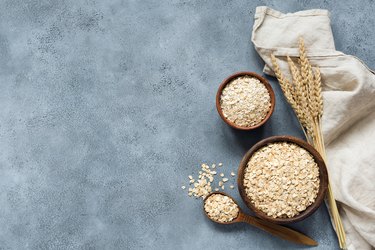
Nothing warms a body on a cold winter morning better than a hot bowl of oatmeal. Unless, of course, you have to wait for it to cook — the biggest difference between rolled oats and instant oats.
Rolled oats, which are whole-grain oats that have been steamed and pressed with a roller to flatten them, take about five minutes to cook, while instant oats, which are basically very thinly pressed rolled oats, are ready as soon as you mix in hot water.
Video of the Day
Video of the Day
While the extra pressing does affect the texture of the oatmeal, instant oatmeal nutrition data is not that much different from rolled oats. However, instant oats are fortified, changing the vitamin and mineral content slightly.
Read more: What Is the Nutritional Value of Oatmeal?
Rolled and Instant Oats Calories
According to the USDA, plain unflavored instant oats calories clock in at 170 while there are 200 calories in the same 1/2 cup serving of rolled oats. Even though the instant oats undergo a little more processing than the rolled oats, both are still considered to be whole grains. The USDA recommends you make at least half your daily grains whole grains.
Instant oats provide 4.2 grams of fiber, while rolled oats have 5 grams of fiber per 1/2-cup cooked serving. The fiber in the oats helps lower cholesterol and may lower your risk of Type 2 diabetes, heart disease and obesity. According to the National Academies of Sciences, men should consume at least 56 grams of protein per day while women need at least 46 grams.
Note the Fat and Protein
A 1/2-cup serving of cooked instant oats contains 3.4 grams of fat or rolled oats contain 4 grams of total fat, but neither contain saturated fat — the "bad" type that can increase blood cholesterol levels and contribute to heart disease, according to Mayo Clinic.
You might find it surprising that the oats contain fat, but as whole grains, the oats retain their germ, endosperm and bran, which contain vitamins, minerals and essential fats.
Instant oats provide nearly 6 grams of protein per serving, while rolled oats have 7 grams. As a plant protein, the oats do not provide all of the essential amino acids. But as long as you include a variety of foods throughout the day, such as vegetables, other grains or beans, you should be able to meet your protein and amino acid needs.
Read more: How Many Calories Are in a Bowl of Oatmeal?
Meet the Minerals
Both instant and rolled oats contain calcium and other minerals, but the amount varies due to fortification. A 1/2-cup serving of fortified instant rolled oats provides 200 milligrams of calcium, according to the USDA, compared with its non-fortified counterpart that only has 20 milligrams.
Another difference between rolled oats and instant oats is their sodium content. Instant oats contain 122 milligrams of sodium, while rolled oats are naturally sodium-free.
According to the American Heart Association, the daily maximum sodium intake for healthy adults should be no higher than 2,300 milligrams. If you have high blood pressure or other related risk factors for heart disease, you should aim for less than 1,500 milligrams per day.
If choosing instant oats that are flavored, such as a packet of cinnamon brown sugar instant oatmeal, expect nutrition facts to increase especially in regards to carbohydrates and sugar.
- USDA: "All About the Grains Group"
- National Academies of Sciences: "Macronutrients"
- Mayo Clinic: "Dietary Fats: Know Which Types to Choose"
- USDA FoodData Central: "Cereals, Oats, Instant, Fortified, Plain, Dry"
- American Heart Association: "How Much Sodium Should I Eat Per Day?"
- USDA FoodData Central: "Cereals, Oats, Instant, Fortified, Plain, Prepared With Water (Boiling Water Added or Microwaved)"
- USDA FoodData Central: "Rolled Oats"